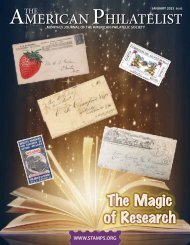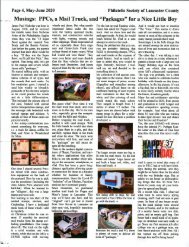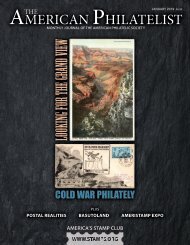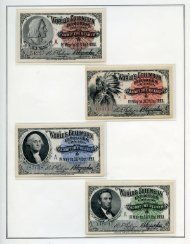February 2018 - Sneak Peek
The American Philatelist is the monthly journal of the American Philatelic Society, the world's largest organization for stamp collectors and enthusiasts. Members receive the printed magazine and can access the digital edition as a benefit of membership in the Society. Please enjoy this sneak peek. We're confident that once you see all that we offer, you'll want to join the APS today.
The American Philatelist is the monthly journal of the American Philatelic Society, the world's largest organization for stamp collectors and enthusiasts. Members receive the printed magazine and can access the digital edition as a benefit of membership in the Society. Please enjoy this sneak peek. We're confident that once you see all that we offer, you'll want to join the APS today.
You also want an ePaper? Increase the reach of your titles
YUMPU automatically turns print PDFs into web optimized ePapers that Google loves.
On August, 18, 1830, Benjamin Dunkan, a dry goods merchant in the hamlet of Mooresville,<br />
Alabama, wrote a letter to the firm of R. Ashhurst & Son of Philadelphia:<br />
Gentlemen, respecting the goods lost on the Oregon you will recollect they were not all mine<br />
as you had put such articles in the invoice as I never ordered viz. …..<br />
The next day, Mr. Dunkan posted his letter at the Stagecoach Inn & Tavern in Mooresville, where it<br />
was postmarked, rated at 25 cents (the rate for a single letter going more than 400 miles), and dispatched<br />
on its way.<br />
Flash forward. In the early 1980s, I became interested in collecting Alabama stampless covers, letters<br />
posted from Alabama towns during the territorial period up until the start of the Civil War. One of the<br />
most difficult Alabama postmarks to find from this period is from Mooresville in Limestone County.<br />
The town – today just off Interstate 565 about 19 miles west of Huntsville – has always been very small<br />
and was off the main commerce routes, so it never generated much mail. Its population was only about<br />
60 when it was incorporated in 1818 by an act of the territorial legislature. Even today, the population<br />
remains in the 50s.<br />
I never expected that I would ever own a Mooresville postmark, given their scarcity. In the early<br />
1990s, a David Phillips postal history auction contained two covers from Mooresville: the first was a<br />
hand-stamped circle-date marking and another was a manuscript postmark. I entered a bid on the<br />
circle-date marking. I bid as much as I was able at that time to pay; and it turned out that my bid was<br />
not even competitive.<br />
Fast forward 20-something years. In a 2012 Daniel F. Kelleher auction, another Mooresville, Alabama<br />
stampless cover was featured [Figure 1]. It may have even been the same one I had bid on two<br />
decades earlier; I can’t remember. It was, however, the first Mooresville cover I had seen offered in the<br />
interim. In more than 30 years of collecting this material, here was only my second chance to acquire a<br />
Mooresville stampless postmark.<br />
I mailed in my bid and anxiously waited for the<br />
auction results to be announced. Eureka! A wave of<br />
excitement washed over me when I learned I had won<br />
this lot. It was followed by a wave of relief when I saw<br />
that the invoice was a few hundred dollars less than<br />
my bid, and safely within my budget. This acquisition<br />
may be the high point of my philatelic career and the<br />
memory of it gratifies me whenever I recall it.<br />
The town of Mooresville still exists today, and in<br />
a condition that a resident from the 1800s might still<br />
recognize. After I received the cover I had won, I decided<br />
to take it back to its point of origin and see the<br />
old town for myself. With my wife and mother-inlaw,<br />
I spent a pleasant Saturday in November walking<br />
the length and breadth of a quaint and picturesque<br />
village that barely encompasses a hundred acres.<br />
Figure 2. The Stagecoach Inn & Tavern, which opened before 1825, served<br />
as Mooresville’s first post office and was the building from which the cover<br />
in this story was mailed. Restored in the 1990s, today it is a museum and<br />
town hall. Photo by Brian Stansberry.<br />
182 Years On, a<br />
Stampless Alabama<br />
Cover Goes Home<br />
BY JOHN YOUNG<br />
Today, Mooresville is a bedroom community hidden<br />
away between Huntsville and Decatur, two of the<br />
main industrial and commercial centers of north Al-<br />
FEBRUARY <strong>2018</strong> / AMERICAN PHILATELIST 141

















